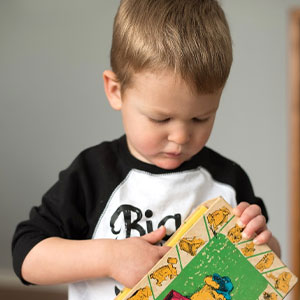If you’re a mom of young children like me I’m sure you’ve had the thought of going to the zoo once or twice. It goes something like this:
The local zoo announces a baby. Let’s say an elephant is born so of course, you go rushing! You get to the zoo (pre-COVID, maybe) and see the beautiful baby elephant, just days old, walking behind their mama. In a short moment, you think back to your child’s infanthood and think, “baby boy(or girl) you had fewer skills than an elephant.” Infant humans, while incredibly squishy, cute, and forever smelling of Dreft and lavender, come into the world with no survival skills.
There are thousands of articles on the importance of early intervention. I spent my bachelor’s degree diving into many of them, followed by stocking my brain with new findings for the past decade. This is in part because I am a researcher by trade. The other part is because I am a nerd for human development. It fills my bucket. In my blog today I’m going to try and give you a snapshot of why development from infancy through kindergarten is so vital. I’m also going to talk about why it’s important for children with autism and our amazing clinics at Instructional ABA Consultants.
Focusing on Child Development Early
OK, let’s get started by going deep. Human infants are born without any skills because their brains need more time to develop than all other mammals. If babies grew into functional toddlers in the womb they could not come out of the birth canal. Women’s bodies are incredible but they aren’t magic; there is a limit to the size of what we can birth (yes, I’m grimacing as I’m writing this because medication-free birth with a newborn is magical, but birthing a toddler? Um…).
So we get these tiny humans, who are desperately in need of being cared for–it’s almost like they are in the womb for an extra three months after delivery. Then they begin to wake up. I remember when both Henry & Declan found their toes and fingers in amazement around three months old.
During this first year of life, thousands upon thousands of neuroconnections are made. Babies are quickly developing their brainpower, motor skills, and language through these high-speed connections. To do this babies need a few simple things. Infants need to be nurtured, to know that when they have a need their parent responds. This creates a secure connection and lets baby know the world is safe. Babies need food and lots of sleep. Once these basics are covered we move into the two most important things; environment and socialization.
Early Socializing & Environments
I like to think of babies, toddlers, and children as little scientists learning through cause and effect. The environment is a huge blank canvas for our children to discover how their world works. Socialization is the tool children need to survive in our culture.
In their early childhood years, these two pieces are so incredibly important because of the rate children can learn. From infancy to year five, children will learn more than any other time in their lives. “What about college,” you say? Nope. These foundational years are the years where connections are made in the brain that last a lifetime.
As a professional, I love looking at how all this heavy lifting helps to shape the outcome of children’s lives. As a mama, I drove myself crazy after Declan was born and I realized I was basically running a school in my home for Henry. This wouldn’t be possible with two kids under two.
This was insanity in hindsight. This was also when I was personally able to take a deep breath and remember what I knew. The two most important things are environment and socialization. It’s not about how “cute” my day is with my boys. It’s about how often they are able to explore and engage. These days you won’t really find me teaching at a table much. Instead, you’ll see a “yes” environment set up (more on this later but basically a safe space to learn), technology out of reach (no TV/no Tablets on the regular as these devices delay both language development & socialization), and lots of talking.
Henry and Declan get to flex their learning muscles through exploration and language. I get to flex my relaxation muscle by not trying to do it all. I’m lucky in that way because my children do not need intervention. If they did I would not be able to sit back because these experiences would need to be contrived. That’s why ABA is so helpful for young children with autism. Here’s why.
The Importance of ABA Therapy for Autism
When a child has autism the neural pathways or roads in the brain that tell that child how to communicate and process information are not forming, either naturally or as quickly as a neurotypical child. The connections are still there to be made but without intervention, a child with autism can’t connect the dots. What this looks like in each child with autism is different but always results in some form of socialization or communication developmental delays. This leaves the child with autism lost in their social world and wondering how to connect.
In applied behavior analysis (ABA), behavioral scientists (BCBAs) are able to assess the language and communication skills missing in early childhood based on developmental milestones. Children with autism are gifted learners but they learn differently because their neural pathways are routed differently. Through assessment, BCBAs are then able to figure out how our little students learn, what skills are missing, and how to connect those missing dots. This happens in three really key ways.
The first is one on one therapy (think personal trainer at the gym) to really teach to the student. The next is to help the child with autism apply what they are learning with their peers. Remember, socialization is hard but children who are neurotypical learn from other children. To strengthen the socialization neuropathway, children with autism need to practice these skills with kids their own age. The last is transferring learned skills back to mama and papa. If a child with autism is in therapy and can do all these skills at a treatment clinic but not at home, the neural pathway is not fully formed.
Therapy at ABA Consultants
Instructional ABA Consultants runs autism clinics for children ages 2 ½ to 6 years old (in addition to our home-based therapy for older children). Our clinics (Naperville & Oak Lawn IL, Castle Rock CO, and coming soon Northside Chicago) have a Preschool Instructor designing the socialization component of our students’ days and BCBAs designing the individualized instruction. Parents are at the core of treatment goals and together we’re helping their precious children make connections in their early development.
Whether you’re a parent of a neurotypical child or a child with autism know that your child’s early years are precious. While we all can dream of our children functioning like that baby elephant walking around fully skilled, the reality is human babies and children need shaping. We’re a social species.
So set down the tablet today, pack up all the toys the marketing teams said you needed, and let your children explore and enjoy. If your child isn’t exploring, jump in and help. If you need help teaching these skills because your child has autism (or this is a new way to parent for you) reach out. We’re all in this crazy world of parenthood together.
XOXO,
Jessie


